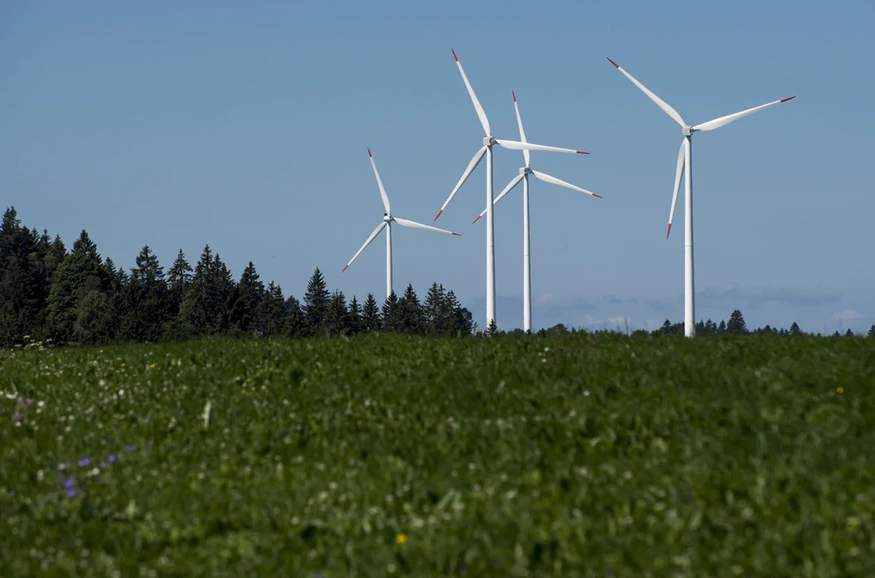The gentle ridges of the Jura mountain range are suitable for the installation of wind turbines (here the Mont-Crosin park, in the Bernese Jura), but most projects are now at a standstill. © Keystone / Jean-christophe Bott For a decade, wind energy in Switzerland has been stalled. Opponents have used every possible means to stop projects. At the end of September, one community will vote on the future of this kind of energy. Power derived from wind is already contributing 20% to the German energy mix. But unlike its northern neighbour, Switzerland does not have extended, empty, flat surfaces of territory. Made up of slopes and valleys, the Swiss landscape does not lend itself to the installation of turbines. Critics of wind power are keen to point this out. But the
Topics:
Swissinfo considers the following as important: 3.) Swiss Info, 3) Swiss Markets and News, Business, Featured, newsletter
This could be interesting, too:
Nachrichten Ticker - www.finanzen.ch writes Die Performance der Kryptowährungen in KW 9: Das hat sich bei Bitcoin, Ether & Co. getan
Nachrichten Ticker - www.finanzen.ch writes Wer verbirgt sich hinter der Ethereum-Technologie?
Martin Hartmann writes Eine Analyse nach den Lehren von Milton Friedman
Marc Chandler writes March 2025 Monthly

The gentle ridges of the Jura mountain range are suitable for the installation of wind turbines (here the Mont-Crosin park, in the Bernese Jura), but most projects are now at a standstill. © Keystone / Jean-christophe Bott
For a decade, wind energy in Switzerland has been stalled. Opponents have used every possible means to stop projects. At the end of September, one community will vote on the future of this kind of energy.
Power derived from wind is already contributing 20% to the German energy mix. But unlike its northern neighbour, Switzerland does not have extended, empty, flat surfaces of territory.
Made up of slopes and valleys, the Swiss landscape does not lend itself to the installation of turbines. Critics of wind power are keen to point this out. But the example of Austria would suggest the opposite. With a mountainous terrain not much different from Switzerland, Austria is already producing 60 times more wind energy.
In the past year, the 40-odd turbines operating in Switzerland produced about 146 million kilowatt hours (kWh), which covers the electricity consumption of just over 36,000 households. This is equivalent to 0.2% of the country’s total electricity consumption. The association for promoting wind power, Suisse Eole, which published these figures, wants 10% of electricity to come from wind power by 2050.
Is this ambition realistic? “The Swiss population generally favours wind power. Of the 22 referendums covering such projects, 19 have achieved a positive result”, says Lionel Perret, head of the wind farmers’ lobby group.
But the opposition is digging in. “Five building projects are still being disputed in the Federal Court”, adds Perret. “Ten others are awaiting decisions from cantons. Even if these sites get the go-ahead, there are no guarantees. We expect further opposition in the courts, particularly from fringe groups.”
The government has identified a number of sites with “wind power potential” without really analysing local and regional factors. It is usually up to cantons to give the green light, but wind farms with a production level of at least 20 gigawatt hours per year are considered to be of “national interest”. But wind power production is still advancing at a crawl.
Last June, Suisse Eole said wind power had stagnated in the last ten years. “Projects are hardly getting off the drawing board or out of the courts”, the lobby group lamented. One example is the proposed 12-turbine development at Mollendruz in western Switzerland. The project was first mooted in 2009. In view of several protest lodged by environmental groups, the fate of the site will eventually be decided by the highest court.
This slow pace makes it hard to fulfil the federal government’s objectives. So much so that Swiss companies in the business of developing wind power are forsaking their home country to sell their expertise abroad.
The slow pace has not, however, stopped turbines from becoming more efficient and effective than before. Technical development has raised productivity. “The yield is two to three times higher than ten years ago”, says Perret. There is also more know-how of wind conditions at high altitudes. It is vital to speed up approval of projects, some of which have been on the drawing board for 20 years, says Perret.
The Bern Jura region – where 16 turbines are in full operation – is being touted as a model. There are even guided tours for interested visitors.
The Jura area in the northwest of Switzerland is one of the zones favoured by the federal government for this kind of green energy. The Federal Court has also ruled this geography to be suitable. Other sites have been built in the Rhône Valley, and the central cantons of Lucerne and Uri.
Work to erect five turbines around the Gotthard pass, which links north and south Switzerland, is in progress. Three turbines are already in place. This new wind farm should start producing green energy in November, meeting the needs of 5,000 households.
Crucial September vote
Situated on the border of cantons Bern and Neuchâtel, the Quatre-Bornes project is subject to a public vote on September 27. The 1,200 inhabitants of one municipality will decide whether to accept ten turbines. Started 15 years ago, the project has failed to garner support from all locals.
Prior to the vote, various challenges were made to this project. They came from the Swiss Foundation to Protect the Countryside, the Swiss Heritage Society (Neuchâtel section), and the town of La Chaux-de-Fonds, which is about ten kilometres away from the site.
The turbines are expected to be visible from the town – and by 300 individuals, including former ski champion, Didier Cuche. A native of the region, he fears the 200-metre high turbines will do harm to the a nature park.
Opponents of the project point to large expenditure on wind power feasability studies and argue that turbines degrade the countryside, makes noise, and drive down the property prices. La Chaux-de-Fonds, designated a Unesco world heritage site in 2009, fears environment damage.
“A disaster for the region”, say opponents, warning of rural sites being turned into industrial zones. They fear that by 2050 a total of 300 turbines will occupy the heights of the Jura mountain range.
Pioneering farmers
The “Yes to Wind Power Energy” committee lobbies in support of wind farms. Members argue that local pioneering farmers – “true visionaries” – thought of wind power long before the government produced its Energy Strategy 2050. The committee says opponents do not even live in the village.
They also point to a consultative vote in 2015 in which three out of four local inhabitants supported the project. Locals will be able to invest in the wind farm, giving them a direct stake in the project.
The turbines are planned to run at 75% capacity, providing 68 million kWh of power, enough to power local communities containing thousands of inhabitants.
The International Energy Agency predicts that by 2027, wind power could become the chief source of energy on the European continent. Despite the powerful winds of opposition blowing against him, Perret remains confident that by 2050 Switzerland can produce some 600 GWh from wind turbines.
Tags: Business,Featured,newsletter








